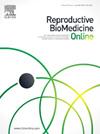SEVERE ELEVATED ANTIMULLERIAN HORMONE LEVEL RELATED TO THE CUMULATIVE LIVE BIRTH RATE AND OBSTETRICS AND PERINATAL OUTCOMES AFTER INTRACYTOPSLASMIC SPERM INJECTION CYCLES?
IF 3.7
2区 医学
Q1 OBSTETRICS & GYNECOLOGY
引用次数: 0
Abstract
Objective
To evaluate the association between intra cytoplasmic sperm injection (ICSI) success and obstetrics and perinatal outcome after ICSI cycle and elevated antimullerian hormone (AMH) levels.
Materials and Methods
A total of 389 ICSI cycles were included retrospectively. All of the participants had serum AMH levels>3.8 ng/ml. Participants were divided into two groups on the basis of their serum AMH levels: Group 1 (AMH= 3.8-7.9 ng/ml) and Group 2 (AMH≥8 ng/ml). Antagonist protocol with gonadotropin were performed for ovarian stimulation. Oocyte pick-up (OPU) was performed 36 hours after ovulation trigger. Embryo(s) was transferred under ultrasound guidance. If patients exhibited evidence of ovarian hyperstimulation syndrome (OHSS) or were at risk of OHSS, embryo transfer (ET) was cancelled and embryos were cryopreserved and in frozen-thaw cycles, embryos were placed in the uterus.
Cumulative rates were calculated until two years after ovum pick up, or exhaustion of preserved embryos before two years, including both fresh ET cycles and subsequent frozen-thaw (FET) cycles. Implantation was defined as positive serum pregnancy test. Clinical pregnancy was defined as a gestational sac with a fetal heart beat detected. Live birth rate was defined as a delivery of a live infant. Abortion was defined as pregnancy loss before 20 weeks of gestation. Gestational complications, anthropometric measures of neonates, admission to neonatal intensive care unit (NICU) and the presence of congenital anomaly were noted.
Results
Demographic features were similar between two groups. Gonadotropin dose performed for ovarian stimulation, endometrial thickness on trigger day and asynchronous follicular development rate were similar between groups. Estradiol levels, the number of cumulus ooforus cells, metaphase II and fertilized oocyte were higher in Group 2 than Group 1 (p<0.05). Ovulation trigger agent was different between the groups (p=0.03). Dual trigger was performed in the most of the Group 1 and analog trigger was performed in the most of the Group 2. No embryo transfer (fresh/frozen-thaw) was performed in 8 cases due to cleavage arrest. All of the cause of the cancelled fresh embryo transfer was OHSS or OHSS risk. Fresh ET was performed in 29.5% of Group 1 and 24.8% of Group 2. Frozen-thaw ET was performed in 70.5% of Group 1 and 75.2% of Group 2. ET day and transferred embryo number were similar between two groups. The two groups had similar cumulative implantation, clinical pregnancy, and abortion rates. However live birth rate was decreased in Group 2 than Group 1 (p=0.04). In Group 1, there was two ectopic pregnancy and one stillbirth. In Group 2, there was one ectopic pregnancy and one stillbirth. Preterm delivery, fetal anthropometric measurements, pregnancy complications, presence of congenital anomaly were comparable between groups (Table 1).
Conclusion
Increased severe AMH levels (≥8 ng/ml) is related to decreased cumulative live birth rates.
求助全文
约1分钟内获得全文
求助全文
来源期刊

Reproductive biomedicine online
医学-妇产科学
CiteScore
7.20
自引率
7.50%
发文量
391
审稿时长
50 days
期刊介绍:
Reproductive BioMedicine Online covers the formation, growth and differentiation of the human embryo. It is intended to bring to public attention new research on biological and clinical research on human reproduction and the human embryo including relevant studies on animals. It is published by a group of scientists and clinicians working in these fields of study. Its audience comprises researchers, clinicians, practitioners, academics and patients.
Context:
The period of human embryonic growth covered is between the formation of the primordial germ cells in the fetus until mid-pregnancy. High quality research on lower animals is included if it helps to clarify the human situation. Studies progressing to birth and later are published if they have a direct bearing on events in the earlier stages of pregnancy.
 求助内容:
求助内容: 应助结果提醒方式:
应助结果提醒方式:


